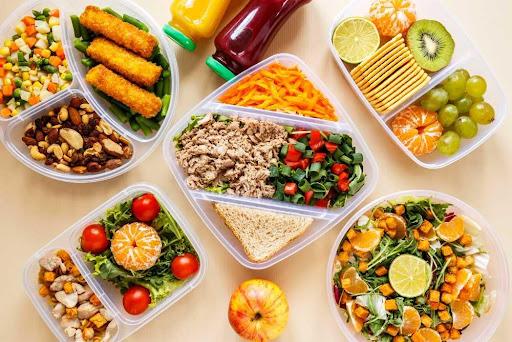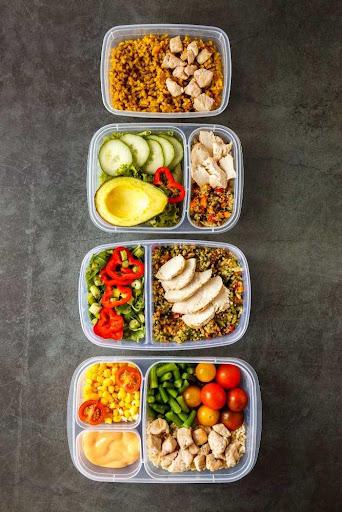

Over the past six decades, there has been a noticeable surge in the average weight of American adults. Although it is tempting to attribute this trend to factors like excessive sugar or fat content in our diet, a more fundamental offender emerges from the consumption of larger
portion sizes.
With the expansion of portion sizes, the caloric intake from even nutritious foods increases. Fortunately, a straightforward solution exists- reducing the food on your plate. By simply downsizing your portions, you can lose weight without requiring additional diet alterations.
This article discusses potion control, providing valuable knowledge and insights.
What is Portion Control?
Portion control is consciously managing the quantity and size of food consumed during a meal or snack. Portion control involves knowing the appropriate measurements or serving sizes based on calorie counts and fat content for various food items and drinks.
The quantity of food you place on your plate is a portion, whereas a serving denotes a specific, predetermined amount. You have to control your food intake to enhance your awareness of your dietary intake.
Portion control is essential for achieving healthy weight loss, as it strikes a balance between excessive calorie consumption and insufficient food intake. It’s about finding a balance between enjoying your food and ensuring that you are not overeating.
Portion Control Techniques
Portion control techniques can enhance a person’s ability to make nutritious dietary choices. By integrating portion sizes into a mindful practice, individuals can effectively manage their food intake and prioritize healthy options.
The first portion control technique is distinguishing between calorie-dense and nutrient-dense foods. Calorie-dense foods are characterized by high-calorie relative to their size, often lacking essential vitamins and minerals. Examples of these foods are juice, candy, and chips.
Nutrient-dense foods offer significant non-calorie nutrients, such as vitamins, fiber, and minerals. Consuming nutrient-dense foods can contribute to prolonged satiety and support healthy weight management or weight loss.
Regardless of your goals, your portion control techniques should prioritize nutrient-dense foods as the bulk constitutes your diet. In contrast, calorie-dense foods have a lower fiber and water content rate.
Mindful Eating Practices
Mindfulness involves the act of attentively observing internal signals and cultivating heightened consciousness. Mindful eating entails a meditation technique that boosts awareness during meals, aiding in curbing impulsive eating and excessive indulgence.
Developing healthy eating habits involves making consistent choices about food daily. By adopting mindful eating practices, individuals can enhance their long-term well-being by boosting their intake of essential nutrients that facilitate optimal growth and development.
A healthy diet’s cornerstone comprises nourishing, nutrient-rich foods from the five essential food groups: dairy, fruits, grains, vegetables, and protein. These high-quality food options provide the foundation for maintaining a well-balanced eating pattern.
Thankfully, the range of wholesome foods accessible today accommodates individual preferences, financial considerations, and diverse cultural backgrounds. By developing the ability to identify the indications of hunger, such as a sensation of emptiness in the stomach, individuals can effectively ascertain when it is appropriate to nourish themselves.
You need to develop an awareness of satiety and contentment to determine the appropriate moment to conclude a meal. As individuals become more acquainted with the bodily signals of hunger and fullness, recognizing these cues becomes simpler.
Several suggestions come up to cultivate mindful eating practices and enhance the overall pleasure derived from eating. To practice mindful eating effectively, consider the following tips:
- Begin with deep breaths: Before commencing your meal, take a few deep breaths to alleviate stress.
- Chew deliberately and take smaller bites.
- Reflect on your satisfaction: This will help you gauge your satiety level.
- Engage your senses: Fully immerse yourself in the sensory experience.
- Eliminate distractions: Prioritize your mealtime by turning off all potential distractions such as phones or other disturbances.

Importance of Portion Control
Portion control is challenging for numerous individuals due to time constraints and uncertainty about allocating calories effectively when hunger strikes. This dilemma often results in overeating or binge eating, contributing to weight gain, health complications, and
potentially fatal consequences.
Thus, it becomes crucial for people to prioritize their eating habits. Here are several compelling reasons why practicing portion control is imperative:
Health Benefits
The impact of a healthy diet extends beyond quantity to encompass food quality. By making conscious choices about what you eat, you can experience various health benefits. These include weight management, healthier cholesterol, and improved blood sugar levels.
Additionally, a nutritious diet can help you avoid unhealthy food options. Practicing portion control not only aids in weight loss but also brings about additional advantages such as enhanced mood and improved sleep.
Implementing portion control helps to ensure that individuals consume the appropriate quantities of food that align with their body type. Moreover, it assists in preventing overeating or inadequate food intake.
Embrace Nourishing Options
Instead of denying yourself, consider integrating healthy alternatives into your eating habits. Opt for a gluten-free snack of your typical choice to avoid losing control and engaging in binge eating.
Engaging in mindful eating can assist you in distinguishing between emotional food cravings and genuine hunger. Portion control entails being present and attentive while consuming meals and avoiding distractions that may hinder your awareness.
To Maintain Consistency in Your Eating Habits
Consistency in your eating habits plays a crucial role in your health, including weight management, blood sugar regulation, and digestive well-being.
Effective meal planning is a vital factor in consistently upholding portion control. By carefully planning your meals, you can guarantee a balanced intake of essential nutrients while avoiding unhealthy food choices. It also allows you to maintain control over your eating habits, preventing excessive consumption during weekends or social gatherings.
It helps Manage Your Food Expenses
A clear understanding of your dietary requirements enables you to manage your food expenses effectively. Consider the number of calories, nutrients, and macronutrients your body needs daily. This knowledge will allow you to determine the appropriate quantity of food to purchase while staying within your budget.
Implementing portion control can also contribute to significant savings on your food bills. It will also ensure that the food you buy lasts longer. It’s important to note that portion control does not imply eating less or skipping meals; instead, it involves aligning your food intake with your daily meal plan.
Assists in Minimizing Waste
The quantity of food waste produced by individuals is astonishing. According to a study conducted in the US, Americans discard approximately one-third of their food annually. However, regrettably, many fail to recognize their tendency to overeat and consume more than necessary.
A practical approach to curbing food waste and saving money is practicing portion control. This entails ensuring that you consume appropriate food and avoiding excess intake. The essence of portion control lies in being mindful of the food you consume.

Ways You Can Do Portion Control
One notable finding is that individuals consume nearly all the food they serve themselves. Consequently, regulating portion sizes can be an effective strategy for avoiding excessive indulgence.
You can adopt these practices, which mainly involve utilizing everyday objects as visual cues for appropriate serving sizes.
Utilize Food Labels
To determine the appropriate amount of food to consume, it’s crucial to consider the type of food. Reading food labels is an excellent way to gauge the number of calories and nutrients in a serving.
Food labels typically provide serving sizes and nutritional information based on a 2,000-calorie-per-day basis. If your daily calorie goal differs from this standard, you may need to adjust the number of servings or portion sizes accordingly.
It may come as a surprise that the packaging of food products only sometimes aligns with a single serving. Therefore, if you consume an entire food package in one sitting, multiply the per-serving values for sugar, calories, and other nutrients by 2.5 to calculate the total intake.
Use the Hand-based References for Measurements
There may be instances where you need access to measuring tools. In such cases, your hand can be a handy measurement reference. However, it is essential to note that this method has limitations as hand sizes may vary among individuals.
To give you a general idea, here are some estimated serving sizes based on hand measurements:
- Fist: Your closed fist can be a reference for estimating a portion size of non-starchy vegetables.
- Palm: When considering protein-rich foods such as meat, fish, or peas, a serving should be roughly equivalent to the size of your palm. It’s best to spread the food on a level rather than piled on top.
- Thumb: You can measure healthy fats, such as nuts or oils, using the size of your thumb as a reference for portion control.
- Cupped hand: If you are looking to gauge a serving of higher carbohydrate foods like grains or starch vegetables, one cupped hand is approximately equivalent to one portion.
Use Smaller Plates
If you need help with the process of measuring or weighing food, you can utilize your plate or bowl as a tool for portion control. The technique below will assist you in determining the ideal ratio of macronutrients for a well-balanced meal.
- Vegetables or Salad: Fill half of your plate.
- High-quality Protein: Allocate a quarter of your plate.
- Complex Carbs: Reserve a quarter of your plate.
- High-fat Foods: Limit these to half a tablespoon.
Drink Water Before Meals
Consider starting every meal with a refreshing glass of water. By doing so, you can naturally regulate your portion sizes. Hydrating yourself with water before a meal can help curb your appetite.
Adequate hydration also assists in distinguishing between hunger and simply being thirsty. A study conducted on middle-aged and older adults found that drinking 17 ounces of water before each meal led to a remarkable 44% reduction in weight over 12 weeks. This weight loss was likely attributed to a decrease in food consumption.
Embrace a Leisurely Pace
Indulging in meals at a rapid pace can leave you oblivious to your body’s signals of satiety, paving the way for overeating. Since it takes roughly 20 minutes for your brain to acknowledge that you’re full after eating, adopting a slower eating habit can help curb your overall food consumption.






















You must be logged in to post a comment Login